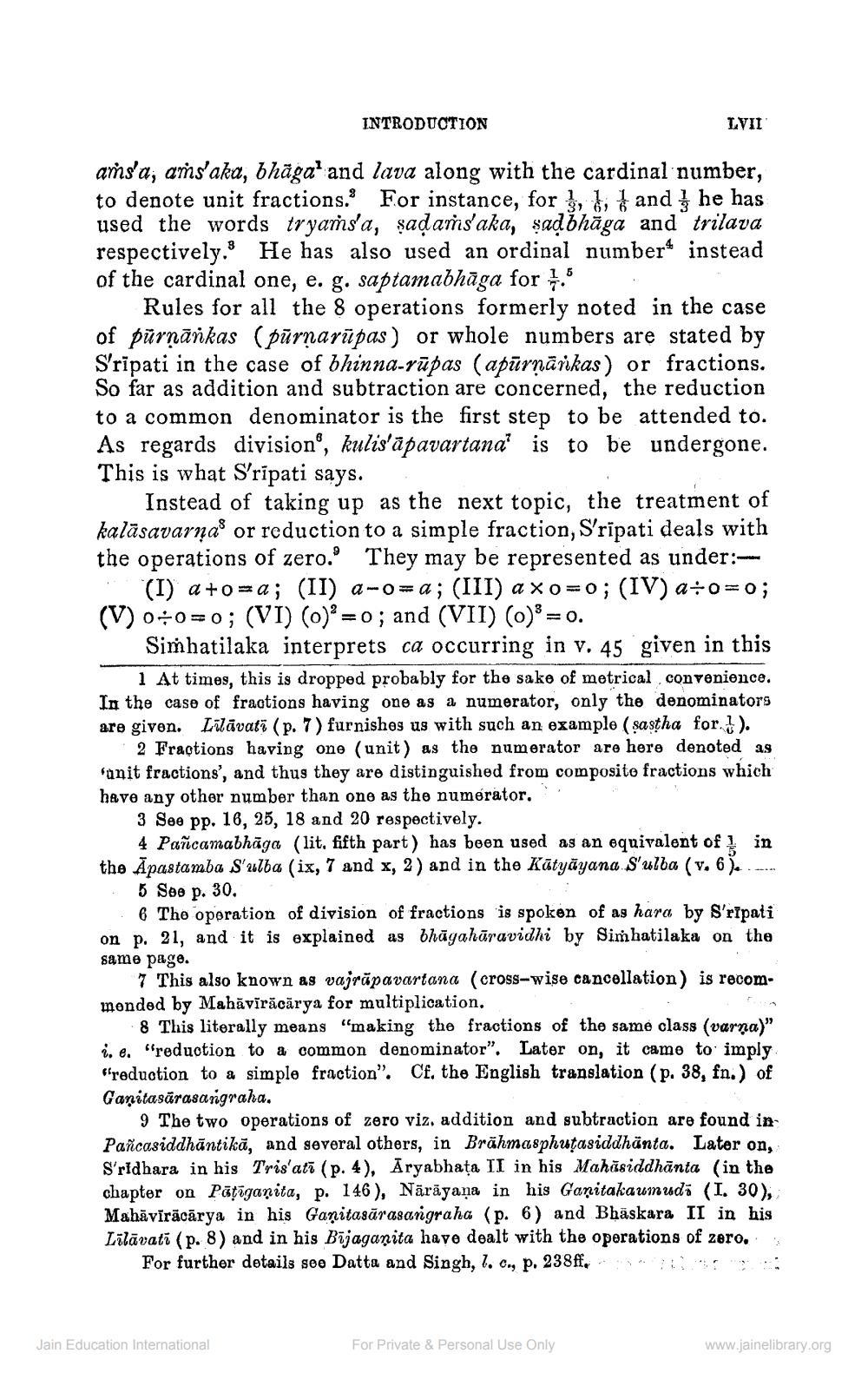________________
INTRODUCTION
LVII
ańs'a, aṁs'aka, bhāga' and lava along with the cardinal number, to denote unit fractions. For instance, for }, ], and he has used the words tryams'a, sadars'aka, sadbhāga and trilava respectively. He has also used an ordinal number* instead of the cardinal one, e. g. saptamabhāga for 7. .
Rules for all the 8 operations formerly noted in the case of pārņānkas (pūrnarūpas) or whole numbers are stated by Sripati in the case of bhinna-rūpas (apūrnārikas) or fractions. So far as addition and subtraction are concerned, the reduction to a common denominator is the first step to be attended to. As regards division", kulis'āpavartana? is to be undergone. This is what Sripati says.
Instead of taking up as the next topic, the treatment of kalāsavarnas or reduction to a simple fraction, Sripati deals with the operations of zero. They may be represented as under:
(I) a +0= a; (II) a-o=a; (III) a x0=0; (IV) a=0=0; (V) 0+0=0; (VI) (0)’=0; and (VII) (0)' = 0.
Simhatilaka interprets ca occurring in v. 45 given in this
1 At times, this is dropped probably for the sake of metrical convenience. In the case of fractions having one as a numerator, only the denominators are given. Lilāvati (p. 7) furnishes us with such an example (sastha for. ).
2 Fractions having one (unit) as the numerator are here denoted as 'unit fractions', and thus they are distinguished from composite fractions which have any other number than one as the numerator.
3 See pp. 16, 25, 18 and 20 respectively.
4 Pañcamabhāga (lit, fifth part) has been used as an equivalent of 1 in the Āpastamba Sulba (ix, 7 and x, 2) and in the Kätyāyana S'ulba (v, 6).
5 See p. 30.
6 The operation of division of fractions is spoken of as hara by Sripati on p. 21, and it is explained as bhāgahāravidhi by Simhatilaka on the same page.
7 This also known as vajräpavartana (cross-wise cancellation) is recommonded by Mahävirācārya for multiplication,
8 This literally means "making the fractions of the same class (varna)" i. e. "reduction to a common denominator". Later on, it came to imply Freduction to a simple fraction". Cf, the English translation (p. 38, fn.) of Ganitasärasangraha.
9 The two operations of zero viz, addition and subtraction are found in Pancasiddhāntikā, and several others, in Brāhmasphutasiddhänta. Later on, S'ridhara in his Tris'atā (p. 4), Āryabhata II in his Mahăsiddhanta (in the chapter on Pațăganita, p. 146), Nārāyaṇa in his Ganitakaumudă (I. 30), Mahāvīrācārya in his Ganitasārasangraha (p. 6) and Bhāskara II in his Līlāvati (p. 8) and in his Bījaganita have dealt with the operations of zero,
For further details see Datta and Singh, l. c., p. 238ff,
Jain Education International
For Private & Personal Use Only
www.jainelibrary.org




